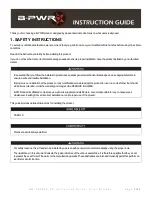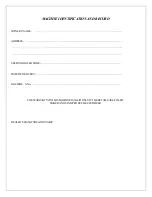
Refrigeration Maintenance
10-13
The primary objective of evacuation is to bring the system’s pressure to a low micron level to ensure the removal of moisture and
non-condensables. There are some other principles that must be observed. These are:
• Evacuate from 3-points to access both sides of check valves and solenoids. Energise solenoids during evacuation to prevent
trapping of refrigerant or non-condensables.
• Always leave service valve caps on during evacuation and do not exercise the valve stems while the unit is in a deep vacuum.
Packing glands on older valves are prone to leak.
• Do NOT attempt evacuation without a micron or vacuum gauge. The micron gauge will help determine:
a. If the pump is capable of pulling a deep vacuum.
b.When the vacuum pump oil is contaminated.
c. If the vacuum hoses and valves are leak free.
d.If the unit is leak free.
e. How long you should evacuate the unit.
f. That the unit is still in a deep vacuum before any lines are disconnected or refrigerant is added.
NOTE: It will be necessary to use a battery charger. Make sure that the battery voltage is sufficient to keep the solenoids
energised when in evacuation mode.
NOTE: The evacuation line to Evacuation pump should be larger than the other 3 lines => this will speed up the evacuation
time.
Set-up and Test Evacuation Equipment
NOTE: This procedure refers to the evacuation under ambient temperature of 15C. The threshold should be adjusted if your
conditions are under this ambient temperature.
1. Install Manifold Gauge
NOTE: A four port manifold should be used.
2. Prepare the unit for evacuation. Recover all refrigerant from the unit and reduce the unit pressure to -0.35 bar, 10 in. Hg
vacuum.
3. Break vacuum with dry nitrogen and equalise pressure to 0 bar, 0 psi. Replace the liquid line filter drier.
4. Connect a 2-stage vacuum pump equipped with a vacuum gauge to the suction service valve, the discharge service valve and
the receiver outlet valve.
5. Back seat the suction service valve and discharge service valve and the receiver outlet valve.
6. If connecting a refrigerant tank to the evacuation pump, close the gauge manifold and refrigerant tank valves to prevent
refrigerant from being drawn from the tank.
7. Open the vacuum valve at the vacuum pump and start the pump.
Summary of Contents for SLXi Spectrum
Page 17: ...Safety Precautions 2 5 Warning Decals...
Page 18: ...Safety Precautions 2 6 Warning Decals Information Decals...
Page 74: ...Unit Description 5 30...
Page 128: ...Controller Operation 7 28...
Page 156: ...Electrical Maintenance 8 28...
Page 234: ...Refrigeration Maintenance 10 22...
Page 309: ...13 Mechanical Diagnosis TK 482 TK 486 and TK 486V Engines 13 2...
Page 316: ...Mechanical Diagnosis 13 8...
Page 322: ...Refrigeration System Diagnosis 14 6...
Page 332: ...Single Temperature Refrigeration System Diagrams 15 10...
Page 339: ...Multi Temperature Refrigeration System Diagrams 16 7...
Page 340: ...Multi Temperature Refrigeration System Diagrams 16 8...
















































